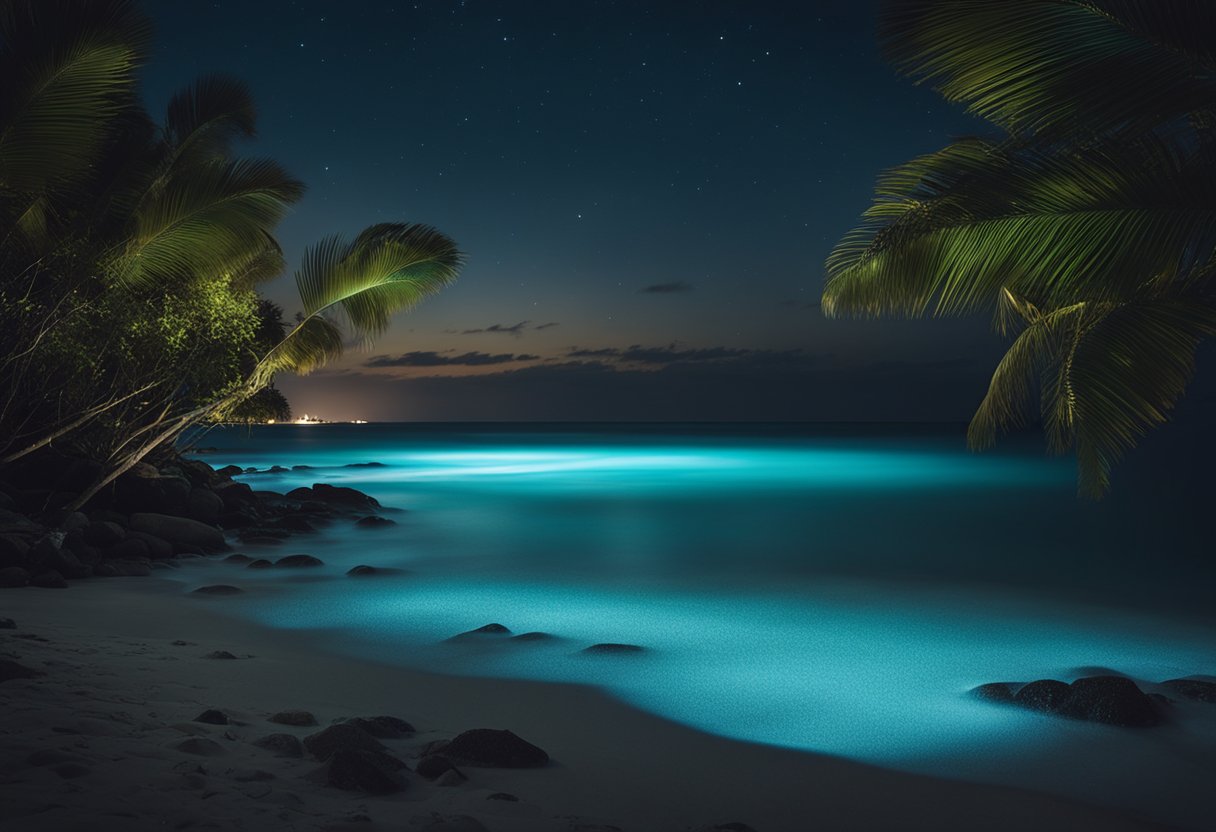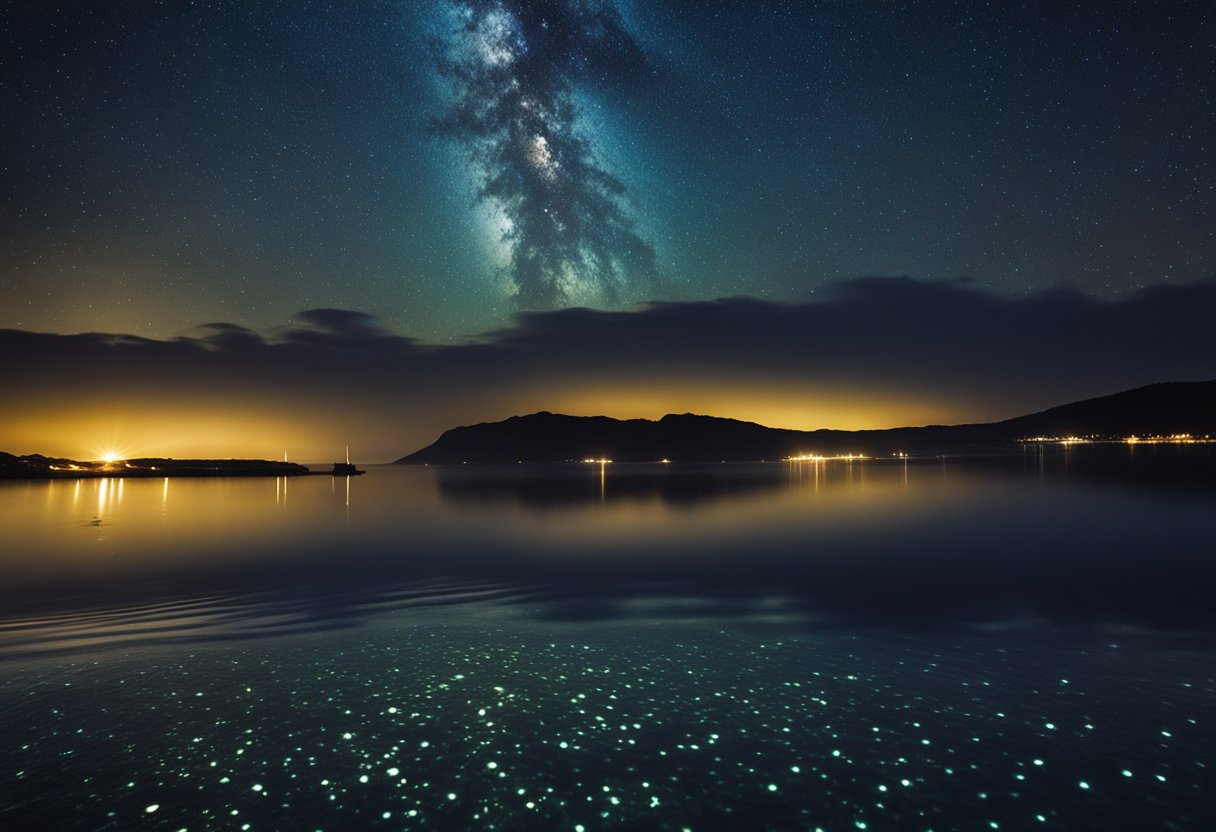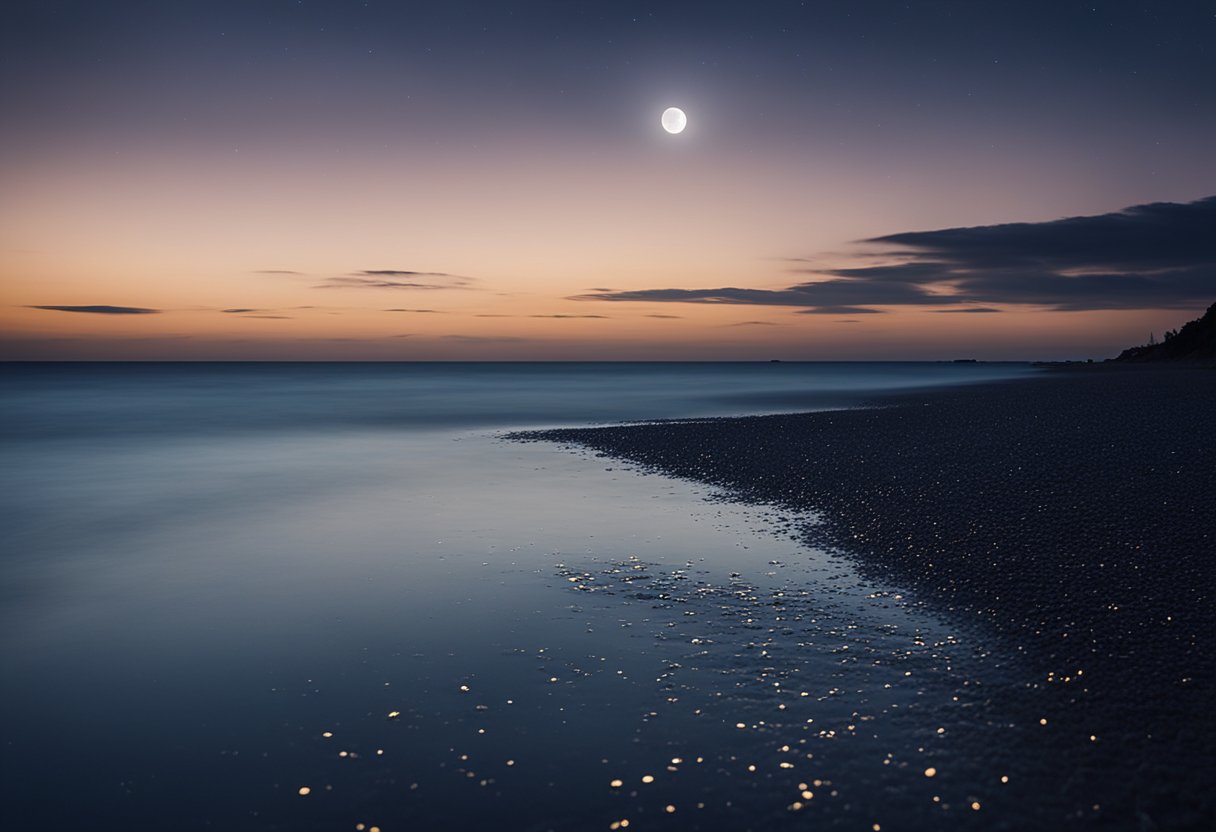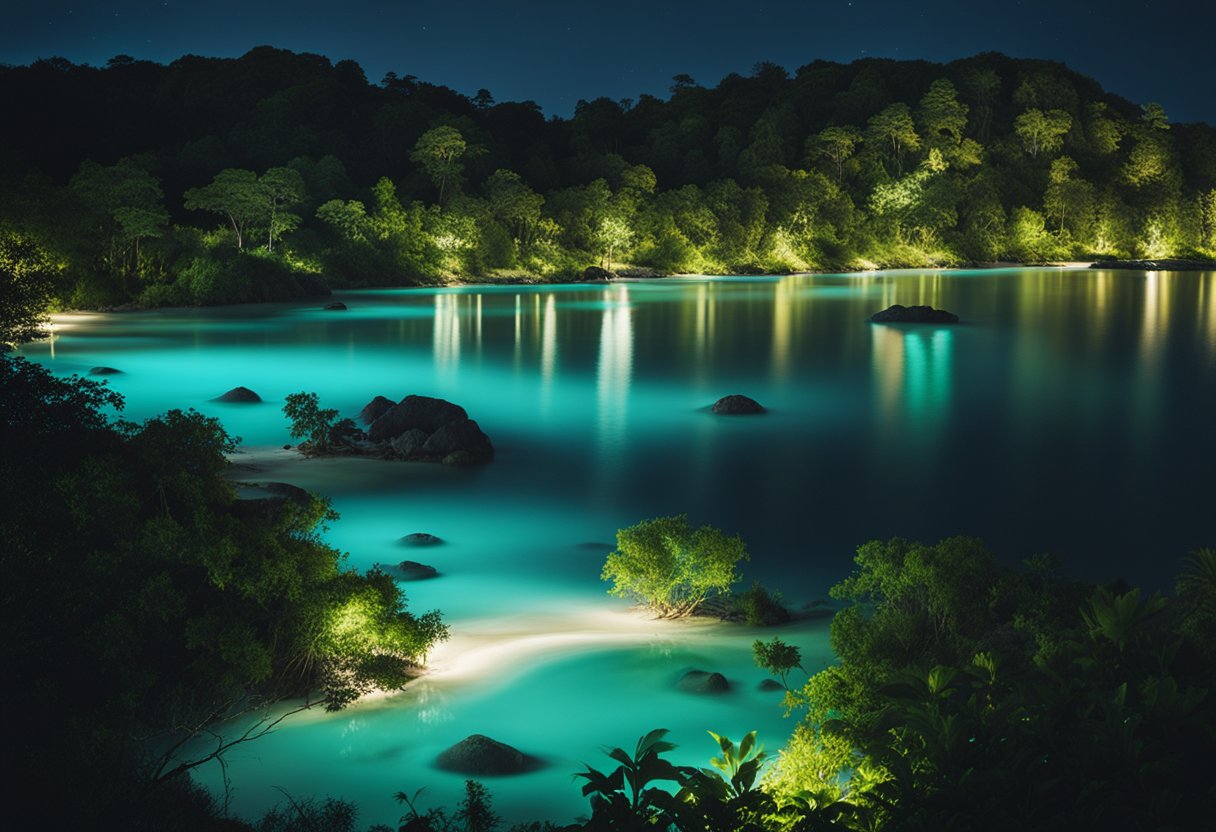Bioluminescent Bays and Beaches: Discover Nature’s Enchanting Nightlights

Updated On: April 04, 2024 by Raghda Elsabbagh
Bioluminescent bays and beaches offer a spectacle that turns the ocean into a canvas of glowing light, making them a marvel of the natural world. This phenomenon occurs when microorganisms in the water, predominantly dinoflagellates, emit light through a chemical reaction within their bodies, illuminating the waves and the shoreline under the right conditions. The display of light is a defence mechanism against predators, creating a breathtaking scene for onlookers.

Across the globe, there are several destinations where this natural light show can be experienced. Certain conditions, such as warmer climates and minimal light pollution, enhance the visibility of bioluminescence, making places like Vieques in Puerto Rico, Toyama Bay in Japan, and the shores of Manasquan, New Jersey, popular among those seeking to witness this luminous display. With growing interest in bioluminescent tourism, it’s imperative to approach these fragile ecosystems responsibly to ensure their preservation for future generations.
Table of Contents
The Science of Bioluminescence
Bioluminescence is a fascinating natural phenomenon where living organisms produce light through a chemical reaction. It’s most commonly seen in the marine environment and is a key adaptation for survival.
The Chemistry Behind the Glow
The light emitted through bioluminescence is the result of a chemical reaction involving a light-emitting molecule called luciferin and an enzyme known as luciferase. When luciferin is oxidised with the aid of luciferase, it produces light. Crucially, this light emission, often referred to as “cold light”, generates very little heat, which is why it’s so efficient in the dark depths of the ocean.
This reaction typically requires oxygen and is regulated within the organism to conserve energy, as producing this light consumes resources. The chemical structures of luciferin and luciferase vary across different species, which results in the variety of colours seen in bioluminescent light, ranging from green to red and blue.
Bioluminescent Organisms in the Ocean
In the realm of marine life, a myriad of organisms exhibit bioluminescence, from microscopic phytoplankton to larger creatures like jellyfish and fish. Foremost among these luminescent beings are dinoflagellates, a type of microorganism often responsible for the glowing waves found in certain bays and beaches around the world.
Dinoflagellates use bioluminescence as a defence mechanism to evade predators, producing a sudden flash of light upon being disturbed, which can startle or temporarily blind their attackers. This clever tactic also serves to attract predators of their predators, creating a cascading set of distractions that allows these microorganisms a chance to escape.
Bioluminescence also occurs in other marine creatures, ranging from tiny shrimp to colossal squid, highlighting an underwater world of communication, predation, and defence, all with the use of natural light.
Best Times and Conditions to Witness Bioluminescence

To experience the breathtaking spectacle of bioluminescence, timing your visit and understanding the natural conditions that favour this phenomenon is crucial.
Moon Phases and Visibility
New Moon: For the best visibility, aim for a moonless night. The absence of moonlight during the new moon phase creates the darkest skies, allowing the natural light of bioluminescent organisms to shine through with stunning clarity.
Full Moon: Conversely, during a full moon, the increased brightness can significantly diminish the visibility of bioluminescence. It’s advisable to schedule your visit around the lunar calendar for optimal viewing conditions.
Seasonal Variations and Optimal Months
Warmer Months: Typically, the warmer months are an ideal time to witness bioluminescence, as the conditions tend to be more favourable for the microorganisms responsible for this natural light display.
The optimal months to visit can vary depending on the location, but generally, the summer and early autumn periods offer a good chance of witnessing this mesmerising event. Keep in mind the importance of high tides, which can enhance the concentration and visibility of these glowing organisms.
Top Bioluminescent Bays and Beaches Worldwide
Our planet is aglow with some of the most awe-inspiring natural phenomena, and none are quite as magical as the spectacle of bioluminescence one can witness at several bays and beaches around the world. These enchanting locales captivate visitors with their nocturnal displays, turning the water into a stunning, star-like field.
Notable Locations in the Caribbean
In the Caribbean, Mosquito Bay, located on the island of Vieques, Puerto Rico, stands out as one of the brightest bioluminescent bays in the world. The presence of dinoflagellates is what makes this bay particularly luminous. Another gem in Puerto Rico is Laguna Grande in Fajardo, renowned for its glittering blue-green waters. Further afield, Luminous Lagoon in Jamaica offers an equally striking experience with its thriving dinoflagellate population.
Luminous Spots in the United States
Across the United States, pockets of bioluminescence can be found from the shores of California to San Diego. These coastal waters are occasionally adorned with neon blue tides due to blooming algae, creating a mystical spectacle for evening beachgoers. Not to be outshined, coastal areas in Florida also host bioluminescent wonders, particularly in the Indian River Lagoon, where kayakers often enjoy the glow during the summer months.
Bioluminescent Hotspots in the Pacific
The Pacific region is home to several remarkable bioluminescent spots. Toyama Bay in Japan is famed for its firefly squids that illuminate the waters. Ha Long Bay in Vietnam and Matsu Island off the coast of Taiwan both present glowing water conditions, thanks to microorganisms that thrive in their waters. Further into the tropical paradise setting, Mudhdhoo Island in the Raa Atoll of the Maldives fascinates with its shorelines that light up at night alongside Koh Rong in Cambodia, which offers extraordinary night swimming experiences surrounded by sparkling plankton.
Experiencing the Magic
Embarking on a tour through bioluminescent bays and beaches is akin to stepping into a realm where the waters themselves become a canvas, aglow with nature’s very own nightlights. Whether it’s via a kayak gliding through the glow or standing on the shore as the waves produce light with each break, the experience is nothing short of enchanting.
Water-Based Adventures
Excursions on the water offer the most direct engagement with the luminous phenomenon of bioluminescence. As we kayak through areas such as the Mosquito Bay, the paddle stirs the water, creating a trail of light that follows us. Swimming is another immersive option, where every movement ignites a glow, illustrating our connection to the natural world in real time. For those seeking guidance, knowledgeable tour guides are on hand, ensuring safe and enlightening adventures through these lite-up waters.
Kayaking
- Navigate through the glowing waters.
- Gentle paddling maximises the visual spectacle.
Swimming
- A sensory experience as you become part of the glow.
- Best enjoyed under the guidance of a local expert.
Coastal Observations
Not all appreciation of bioluminescent bays needs to come from being in the water. Observations from the beach offer a serene way to witness this natural marvel. The sight of waves breaking upon the shore, each crest a burst of radiant light, is a profound and peaceful experience. We recommend timing your visit in agreement with lunar cycles; with less moonlight, the bioluminescence becomes even more pronounced. So, let the rhythm of the waves and the soft glow guide your coastal observations for a memorable night under the stars.
- Beach Spectating
- Watch the light show from the safety of the shore.
- Ideal for photography and serene contemplation.
Environment and Conservation Concerns

Bioluminescent bays and beaches are a testament to the delicate balance of ecosystems. These natural wonders face unique challenges that demand our attention if we are to preserve them for future generations.
The Impact of Pollution on Bioluminescence
Pollution is a significant threat to bioluminescent habitats. The flicker and glow we marvel at are produced by organisms that can be highly sensitive to changes in their environment. Pollutants such as heavy metals and chemicals disrupt these organisms, often leading to a diminished glow or, in some cases, the death of the light-producing plankton. Monitoring pollution levels and enforcing regulations is crucial in safeguarding the bioluminescent phenomena parties, jetskis, second homes.
Sustainable Tourism and Ethics
The popularity of bioluminescent bays as tourist attractions has grown, which, while beneficial economically, poses risks to their sustainability. We believe in sustainable tourism practices that minimise impact and sustain local communities. Guidelines for interaction with these bays, such as limiting the number of visitors per night and prohibiting the use of motorised watercraft, help maintain the natural balance. Furthermore, we see the ethics of tourism not just as a set of rules but as a communal effort to appreciate and conserve these marvels. Engaging in ethical tourism ensures that we contribute to the conservation rather than the degradation of these delicate environments of Puerto Rico’s bioluminescent bays.
Encounters with Bioluminescent Marine Life
Bioluminescent bays and beaches illuminate the natural world, revealing a hidden universe of light under the waves. Here, we venture into the nocturnal realms of the ocean to discover the glowing creatures that call these depths home.
Mesmerising Marine Fauna
The shallow waters are alive with an array of bioluminescent organisms. Fish and jellyfish often steal the spotlight, their bodies emanating a ghostly glow. It’s a defence mechanism, confusing predators and allowing these marine life forms to communicate or even court potential mates. The bobtail squid, for instance, harbours bioluminescent bacteria in its mantle cavity, which helps it camouflage against moonlit waters.
The Mystery of Deep-Sea Bioluminescence
Venturing deeper, the ocean’s enigma unfolds in the realm of deep-sea bioluminescence. Creatures like the anglerfish, with its luminescent lure, have adapted to the perpetual night of the deep ocean, where light is a precious commodity. The complexity of this environment and its inhabitants echo a world where light is strategically used to attract, repel, or even disguise in the eternal dance for survival.
Planning Your Bioluminescent Adventure
Embarking on a bioluminescent adventure requires preparation to ensure a safe and magical experience. We’re here to guide you through the practical steps and necessary precautions to make your nocturnal journey unforgettable.
Practical Tips for Visitors
When planning to visit bioluminescent bays or beaches, consider the timings of natural phenomena that affect the spectacle, such as lunar cycles. The darker the night, the more vivid the bioluminescence—aim for a trip during a new moon when the glow will be at its brightest. Additionally, most bioluminescent locations are remote, so think about transportation. You may need to take a ferry or a plane to reach islands such as Vieques, where Puerto Rico’s brightest bioluminescent bay, Mosquito Bay, is located. These services usually follow strict schedules, so booking tickets in advance is wise.
Before visiting, always check access permissions and the operational status of the bays. In some cases, conservation efforts may limit the number of visitors per night.
- Mosquito Bay, Vieques: Given its reputation for the stronger bioluminescent display, start planning your visit here several weeks in advance.
- Laguna Grande, Fajardo: Accessible by a short ferry ride from mainland Puerto Rico; remember to check the latest timetable.
- La Parguera, Lajas: Offers night-time swims in the glowing waters, but come prepared with insect repellent as mosquitoes are prevalent.
Equipment and Precautions
Before you head out, make sure to pack the right equipment. Here’s a concise checklist for your bioluminescent adventure:
| Must-Have Items | Why It’s Needed |
|---|---|
| Insect repellent | To protect against mosquito bites |
| Water-proof camera | To capture the phenomenon without damage |
| Navigation tools | To ensure you can find your way in the dark |
A waterproof camera or a protective case for your phone will allow you to take pictures of the bioluminescence without risking damage to your electronics. However, capturing the phenomenon can be challenging, so managing expectations regarding photo quality is essential.
As for precautions, environmental consciousness is crucial. It’s imperative to avoid using any lotions or substances that could harm the delicate ecosystems. If swimming is allowed, take care not to stir up sediment, as this can negatively impact the organisms causing the glow. Always follow the guidance of local tour operators who understand the best practices for interacting with these unique environments.
Capturing the Glow: Photography Tips
When photographing nature’s mesmerising light shows, we’re embarking on a quest to capture the ephemeral beauty of bioluminescent bays and beaches. Here are some essential tips to guide us through snapping those glowing scenes:
1. Research Your Location:
We must scout for spots where bioluminescence is known to occur. Look for sheltered bays and coves that have previous records of this natural phenomenon.
2. Understand the Conditions:
Bioluminescence tends to peak in warmer months. Align our visits with the tide schedule, as the glowing organisms often become more visible during high tide at night.
3. Camera Settings:
- Set the camera to manual mode.
- Use a tripod for stability.
- Opt for a wide aperture (low f-stop number) to allow maximum light.
- Increase ISO, but be mindful of noise.
- Slow shutter speed is crucial – start at 15 seconds and adjust as needed.
4. Composition Techniques:
- Frame the shot with foreground interest to add depth.
- Consider the rule of thirds for a balanced composition.
- Patience is key; take multiple exposures to capture the perfect moment.
5. Practice Ethical Photography:
Let’s respect the environment by minimising our impact. Avoid flash photography and be careful not to disturb the habitats we are there to appreciate.
For further reading on capturing bioluminescence, consider visiting the Digital Camera World guide for additional expert advice.
By following these tips, we can immortalise the otherworldly glow of bioluminescent bays and beaches, creating images that remind us of nature’s unparalleled beauty.
Understanding Bioluminescent Tourism
The rise of bioluminescent tourism has brought attention to the fascinating natural phenomenon of glowing waters. In this section, we’ll examine the impact this type of tourism has on local economies and delve into the cultural importance of these luminous shores.
Local Economies and Bioluminescence
The introduction of bioluminescent tourism has opened up a new revenue stream for areas near these natural attractions. Guided tours that lead curious travellers to witness the spectacle of glowing waters at night have become increasingly popular. For instance, the presence of several bioluminescent bays in Puerto Rico supports the local economy by creating jobs ranging from tour guides to transportation services. These tours not only bring in visitors but also help sustain local businesses such as restaurants, hotels, and souvenir shops.
Cultural Significance of Glowing Waters
The glowing waters hold deep cultural significance in areas where this phenomenon is prominent. Locally, these bioluminescent waters may be entwined with folklore or considered sacred. For instance, the glow-in-the-dark waters of Mosquito Bay could also serve as a backdrop for storytelling and cultural exchange, giving visitors a deeper understanding of the region’s heritage. By engaging with these experiences, we can gain insight into the ways different cultures interact with and interpret natural wonders.
Myths and Legends of Glowing Seas
In cultures across the world, bioluminescent phenomena have sparked the human imagination, weaving a tapestry of myths and legends around the natural glow of our seas. These enchanting waters have given rise to countless stories, often seen as messages from the gods or omens of otherworldly forces at play.
The Ancients’ Interpretations
- Greeks: They often attributed the bioluminescence to the influence of the gods and folklore creatures.
- Norse: In Nordic legends, such waters could be the mischief of light-emitting creatures from mythical realms.
In Puerto Rico, home to the famous Mosquito Bay, local tales talk of the glowing waters being the work of the spirit ‘Yokahu’, who blessed the waters with eternal light. While in New Zealand, Māori legends refer to ‘Titiwai’—the glowing larval stage of a fungus gnat—which they believed to be the lights of departed souls.
The natural beauty and mystery of these glowing seas have deeply influenced coastal communities, shaping evening tales and nighttime rituals. These stories, while differing in origins, carry a shared sense of awe and reverence for the extraordinary sights bestowed by nature. Often, such tales are intertwined with cultural values and serve as a reminder of our connection to the natural world.
Bioluminescence continues to inspire new myths, merging ancient perspectives with contemporary understandings. As we explore further, let’s remind ourselves that these living, glowing waters are not just a spectacle but a vital part of our world’s ecology and cultural heritage.
The Future of Bioluminescence Research

In the ever-evolving landscape of science, the illumination provided by bioluminescence continues to spark significant interest. Our understanding and applications of this natural phenomenon are set to broaden the horizons of both technology and medicine.
Advancements in Scientific Understanding
Bioluminescence has long been a subject of fascination, with its natural glow gracing both terrestrial and marine environments. Our research endeavours have unearthed a plethora of organisms that possess this glowing capability, each revealing unique biochemical pathways. Moving forward, expectations are high for discovering new bioluminescent systems, as reported in a Nature article on the quantification of bioluminescence. These discoveries are paving the way for a deeper comprehension of the genetic and molecular foundations of bioluminescence and its evolution.
Scientists are also working on mapping the distribution patterns of bioluminescent organisms, which will enhance our ecological understanding. For example, research has shown varied uses for bioluminescence in nature, from attracting mates to deterring predators. The applications of bioluminescence in biotechnology and beyond hold promise for new scientific breakthroughs.
Potential Applications in Technology and Medicine
The glow of bioluminescence is not just a spectacle but also a powerful tool for innovation. Recent strides in the field offer promising applications in biomedical imaging, as demonstrated by researchers like Andy Yeh, who received substantial funding to develop bioluminescent proteins for medical purposes. These proteins could revolutionise medical diagnostics, allowing for non-invasive imaging of cellular processes and diseases.
In technology, bioluminescence is inspiring the creation of sustainable light sources and biosensors. Our future might shine brighter with eco-friendly bioluminescent lighting, lessening the reliance on electrical energy. Moreover, this natural light phenomenon is advancing sensor development, enabling the detection of toxins and pollutants with high sensitivity. The integration of bioluminescent reporters into various technologies continues to expand, illuminating possibilities in environmental monitoring and safety assessments.
Frequently Asked Questions
We’ve gathered some of the most common queries related to bioluminescent bays and beaches to help you understand and appreciate these natural wonders.
What safety considerations should be observed when swimming in bioluminescent waters?
Swimming in bioluminescent waters is a mesmerising experience, but safety comes first. Always swim in designated areas and follow local regulations. Be mindful of marine life, respect the ecosystem, and ensure you do not disturb the habitat with excessive movement or chemicals such as sunscreen and insect repellents.
During which months is bioluminescence most visible in Tomales Bay?
Bioluminescence in Tomales Bay is typically most visible during the warmer months, from late summer to early autumn. The best visibility is on nights without moonlight when microorganisms in the water are more discernible.
Where in California can one witness bioluminescent phenomena?
California offers several spots known for bioluminescent displays, such as Mission Bay, Newport Bay, and the infamous Red Tide at various beaches along the coast. These natural light shows can vary by location and time of year.
When is the optimal period to observe bioluminescent waves?
The optimal period to observe bioluminescent waves is usually during new moons when the skies are darkest. This darkness allows the bioluminescence to stand out more prominently.
Which factors contribute to the intensity of bioluminescence in coastal waters?
Factors such as water temperature, movement, and the concentration of organisms like dinoflagellates contribute to the intensity of bioluminescence in coastal waters. Nutrient availability in the water can also affect the brightness and frequency of bioluminescent events.
How does one differentiate between various bioluminescent bays and beaches?
Each bioluminescent bay or beach has unique characteristics, such as the species that cause the glow and environmental conditions. Differentiating them involves understanding the specific types of bioluminescent organisms present and their peak activity periods.






